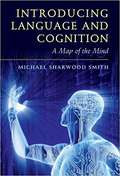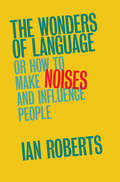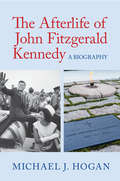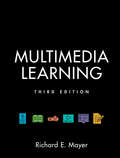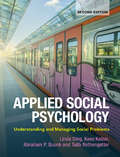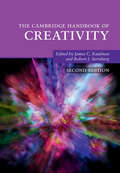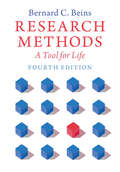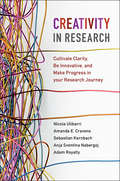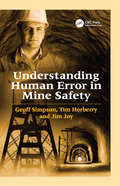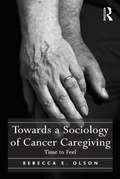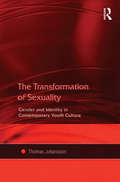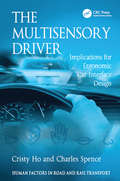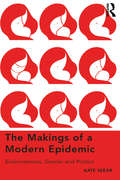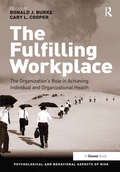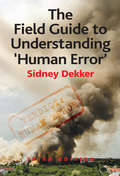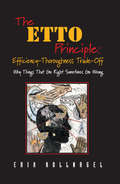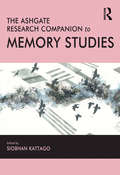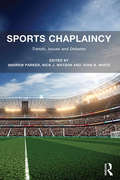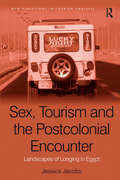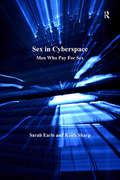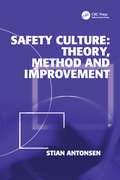- Table View
- List View
The Cambridge Handbook of the Psychology of Prejudice
by Sibley Chris G. Barlow Fiona KateThe Cambridge Handbook of the Psychology of Prejudice aims to answer the questions: why is prejudice so persistent? How does it affect people exposed to it? And what can we do about it? Providing a comprehensive examination of prejudice from its evolutionary beginnings and environmental influences through to its manifestations and consequences, this handbook is an essential resource for scholars and students who are passionate about understanding prejudice, social change, collective action, and prejudice reduction. Featuring cutting-edge research from top scholars in the field, the chapters provide an overview of psychological models of prejudice; investigate prejudice in specific domains such as race, religion, gender, and appearance; and develop explicit, evidence-based strategies for disrupting the processes that produce and maintain prejudice. This handbook challenges researchers and readers to move beyond their comfort zone, and sets the agenda for future avenues of research, policy, and intervention.
Introducing Language and Cognition
by Smith Michael SharwoodIn this accessible introduction, Mike Sharwood Smith provides a working model or 'map' of the mind, with language as its centrepiece. Drawing on cutting-edge research across linguistics, psychology and neuroscience, it allows students to quickly grasp how each separate aspect of the mind's operations can be related. This 'big picture' view includes the way the mind makes, stores and loses memories of all kinds as well how its various 'expert systems' combine and collaborate to solve, typically beyond our conscious awareness, the myriad of tasks we are faced with every minute and millisecond of our existence. The book also focuses on language, that is, the mind of monolingual, bilingual and multilingual speakers. It will be of interest to all students wishing to learn more about the complex relationship between language - one of the most important ways in which we define ourselves as human - and the mind.
Substance and Behavioral Addictions
by Steve SussmanSubstance and Behavioral Addictions: Concepts, Causes, and Cures presents the concepts, etiology, assessment, prevention, and cessation of substance (tobacco, alcohol, other drugs, and food) and behavioral (gambling, Internet, shopping, love, sex, exercise, and work) addictions. The text provides a novel and integrative appetitive motivation framework of addiction, while acknowledging and referencing multi-level influences on addiction, such as neurobiological, cognitive, and micro-social and macro-social/physical environmental. The book discusses concurrent and substitute addiction, and offers prevention and treatment solutions, which are presented from a more integrative perspective than traditional presentations. This is an ideal text for upper-level undergraduates and graduate students, practitioners, and researchers.
The Age of Charisma
by Young Jeremy C.An innovative examination of American society, culture, and politics, The Age of Charisma argues that the modern relationship between American leaders and followers grew out of a unique group of charismatic social movements prominent in the late-nineteenth and early-twentieth centuries. Drawing on hundreds of letters and testimonials, Jeremy C. Young illustrates how 'personal magnetism' in public speaking shaped society by enabling a shift from emotionally-inaccessible leadership to emotionally-available leadership. This charismatic speaking style caused a rapid transformation in the leader-follower relationship, creating an emotional link between speakers and listeners, and the effects of this social transformation remain with us today. Young argues that ultimately, charismatic movements enhanced American democracy by encouraging the personalization of leadership - creating a culture in which today's leaders appeal directly to Americans through mass media.
Cambridge Studies in Law and Society: Buried in the Heart
by Erin BainesIn Buried in the Heart, Erin Baines explores the political agency of women abducted as children by the Lord's Resistance Army in northern Uganda, forced to marry its commanders, and to bear their children. Introducing the concept of complex victimhood, she argues that abducted women were not passive victims, but navigated complex social and political worlds that were life inside the violent armed group. Exploring the life stories of thirty women, Baines considers the possibilities of storytelling to reclaim one's sense of self and relations to others, and to generate political judgement after mass violence. Buried in the Heart moves beyond victim and perpetrator frameworks prevalent in the field of transitional justice, shifting the attention to stories of living through mass violence and the possibilities of remaking communities after it. The book contributes to an overlooked aspect of international justice: women's political agency during wartime.
The Wonders of Language
by Ian RobertsIan Roberts offers a stimulating introduction to our greatest gift as a species: our capacity for articulate language. We are mostly as blissfully unaware of the intricacies of the structure of language as fish are of the water they swim in. We live in a mental ocean of nouns, verbs, quantifiers, morphemes, vowels and other rich, strange and deeply fascinating linguistic objects. This book introduces the reader to this amazing world. Offering a thought-provoking and accessible introduction to the main discoveries and theories about language, the book is aimed at general readers and undergraduates who are curious about linguistics and language. Written in a lively and direct style, technical terms are carefully introduced and explained and the book includes a full glossary. The book covers all the central areas of linguistics, including phonetics, phonology, morphology, syntax, semantics and pragmatics, as well as historical linguistics, sociolinguistics and psycholinguistics.
The Afterlife of John Fitzgerald Kennedy
by Hogan Michael J.In his new book, Michael J. Hogan, a leading historian of the American presidency, offers a new perspective on John Fitzgerald Kennedy, as seen not from his life and times but from his afterlife in American memory. The Afterlife of John Fitzgerald Kennedy considers how Kennedy constructed a popular image of himself, in effect, a brand, as he played the part of president on the White House stage. The cultural trauma brought on by his assassination further burnished that image and began the process of transporting Kennedy from history to memory. Hogan shows how Jacqueline Kennedy, as the chief guardian of her husband's memory, devoted herself to embedding the image of the slain president in the collective memory of the nation, evident in the many physical and literary monuments dedicated to his memory. Regardless of critics, most Americans continue to see Kennedy as his wife wanted him remembered: the charming war hero, the loving husband and father, and the peacemaker and progressive leader who inspired confidence and hope in the American people.
Multimedia Learning (Cambridge Handbooks In Psychology Ser.)
by Richard MayerAdvances in computer graphic technologies have inspired new efforts to understand the potential of multimedia instruction as a means of promoting human learning. In Multimedia Learning, Third Edition, Richard E. Mayer takes an evidence-based approach to improving education using well-designed multimedia instruction. He reviews 15 principles of multimedia instructional design that are based on more than 200 experimental research studies and grounded in a cognitive theory of how people learn from words and graphics. The result is the latest instalment of what Mayer calls the Cognitive Theory of Multimedia Learning, a theory introduced in previous editions of Multimedia Learning and in The Cambridge Handbook of Multimedia Learning, Second Edition. This edition provides an up-to-date and systematic summary of research studies on multimedia learning, supplemented with complementary evidence from around the globe. It is well-suited to graduate and undergraduate courses in psychology, education, computer science, communication, instructional design, and game design.
Applied Social Psychology
by Linda Steg Kees Keizer Buunk Abraham P. Talib Rothengatter`I think this is a wonderful book. The social psychological theories are exceptionally well presented for practical use. Anyone studying social psychology will find this book extremely relevant and accessible' - Gerjo Kok, Professor of Applied Psychology, Department of Work and Social Psychology, Maastricht University `This is a highly readable book dealing with an exciting topic, applied social psychology, which is at the heart of many urgent problems of the new millennium. It is well suited for curing the disease of those who still believe there is an opposition between fundamental and applied research, between theories and practice. The major asset of this volume lies in the originality and strength of the PATH concept -- from problem definition, over analysis, and test, to helping. I like the idea to implement and institutionalize this framework in teaching and in education' - Klaus Fiedler, University of Heidelberg Introducing a new methodological approach for doing applied psychology, the PATH model, this book offers a simple, systematic, step-by-step, easy-to-use methodology for applying primarily social psychological theory to a wide range of social problems, from tackling crime and prejudice to fostering environmental conservation and team performance. It helps and guides students to define a problem, conduct a theory-based analysis, develop an explanatory model, set up and execute a research project to test the model, and develop an intervention. Applying Social Psychology is a highly practical text, which can be used by introductory and advanced level students who want to learn how to analyze practical problems and develop solutions for these problems based upon social psychological theory and research. Written in an engaging and accessible way, this book offers: 1. A new methodological model put forward by the authors (PATH model); 2. Real world case studies; 3. End of chapter exercises; 4. Interviews with leading social psychologists; 5. Glossary of key theories and concepts in social psychology; 6. Recommended further reading.
The Cambridge Handbook of Creativity (Cambridge Handbooks in Psychology)
by James C. Kaufman Robert J. SternbergThis second edition of the renowned Cambridge Handbook of Creativity expands on the first edition with over two thirds new material reaching across psychology, business, entrepreneurship, education, and neuroscience. It introduces creativity scholarship by summarising its history, major theories and assessments, how creativity develops across the lifespan, and suggestions for improving creativity. It also illustrates cutting-edge work on genetics and the neuroscience of creativity, alongside creativity's potential for both benevolence and malevolence. The chapters cover the related areas of imagination, genius, play, and aesthetics and tackle questions about how cultural differences, one's physical environment, mood, and self-belief can impact creativity. The book then examines the impacts on creativity of behaviour by teachers, managers, and leaders in particular.
Research Methods: A Tool for Life
by Bernard C. BeinsResearch Methods is an introduction to the importance of scientific research in everyday life and uses familiar examples to keep students engaged. The text analyzes controversies in psychology to stimulate student interest while explaining crucial methodological concepts. It presents ethical issues related to research, as well as social and cultural factors that might affect it, and provides a comprehensive introduction to a wide variety of methodologies. Through this book, students will learn how to generate research questions and select appropriate methodology, as well as to write a successful research report.
Creativity in Research: Cultivate Clarity, Be Innovative, and Make Progress in your Research Journey
by Nicola Ulibarri Amanda E. Cravens Anja Svetina Nabergoj Sebastian Kernbach Adam RoyaltyCreativity is at the heart of successful research, yet researchers are rarely taught how to manage their creative process, and modern academic life is not structured to optimize creativity. Creativity in Research provides concrete guidance on developing creativity for anyone doing or mentoring research. Based on a curriculum developed at Stanford University's Hasso Plattner Institute of Design, this book presents key abilities that underlie creative research practice through a combination of scientific literature on creative confidence, experiential exercises, and guided reflection. By focusing attention on how research happens as well as its outputs, researchers increase their ability to address research challenges and produce the outputs they care about. Simultaneously, they may also transform their emotional relationship with their work, replacing stress and a harsh inner critic with a more open and emotionally empowered attitude.
Understanding Human Error in Mine Safety
by Tim Horberry Geoff SimpsonThe consideration of human factors issues is vital to the mining industry. As in other safety-critical domains, human performance problems constitute a significant threat to system safety, making the study of human factors an important field for improving safety in mining operations. The primary purpose of this book is to provide the reader with a much-needed overview of human factors within the mining industry, in particular to understand the role of human error in mine safety, explaining contemporary risk management and safety systems approaches. The approach taken is multidisciplinary and holistic, based on a model of the systems of work in the mining industry domain. The ingredients in this model include individual operators, groups/teams, technology/equipment, work organisation and the physical environment. Throughout the book, topics such as human error and safety management are covered through the use of real examples and case studies, allowing the reader to see the practical significance of the material presented while making the text rigorous, useful and enjoyable. Understanding Human Error in Mine Safety is written for professionals in the field, researchers and students of mining engineering, safety or human factors.
Towards a Sociology of Cancer Caregiving: Time to Feel
by Rebecca E. OlsonOnce a synonym for death, cancer is now a prognosis of multiple probabilities and produces a world of uncertainty for carers. Drawing on rich, in-depth interview data and employing interactionist theories, Towards a Sociology of Cancer Caregiving explores carers' lived experiences, paying close attention to the ways in which spouse carers manage the ambiguity that pervades their orientations to the future, their responsibilities and their emotions. A detailed exploration of the temporal and emotional journeys of spouse carers of cancer patients, this volume raises and responds to new questions about how to conceptualise informal caregiving, offering a fresh theorisation of the uncertainty that now characterises cancer. As such, it will appeal to scholars of the sociologies of emotion, time and identity, and all those interested in the question of how to support informal carers.
The Transformation of Sexuality: Gender and Identity in Contemporary Youth Culture
by Thomas JohanssonHow do contemporary young people construct their sexual identities? Are young people sexually liberated, or is human sexuality increasingly controlled and manipulated by commercial forces? Thomas Johansson explores the construction of sexual identities by young people as part of a wider process of identity construction, combining the work of key authors such as Elias and Foucault with original and revealing empirical material drawn from an extensive survey of the views of 1300 sixteen to nineteen year olds, combined with a number of qualitative in-depth interviews with different sexual subcultures. Topics covered include fidelity and infidelity, love, homosexuality, pornography and beauty ideals. Designed to look beyond media images and popular prejudices the book illustrates how young people of both genders, of different nationalities and of different group allegiances view and relate to their own sexuality.
The Multisensory Driver: Implications for Ergonomic Car Interface Design (Human Factors in Road and Rail Transport)
by Cristy Ho Charles SpenceDriver inattention has been identified as one of the leading causes for car accidents. The problem of distraction while driving is likely to worsen, partly due to increasingly complex in-car technologies. However, intelligent transport systems are being developed to assist drivers and to ensure a safe road environment. One approach to the design of ergonomic automobile systems is to integrate our understanding of the human information processing systems into the design process. This book aims to further the design of ergonomic multisensory interfaces using research from the fast-growing field of cognitive neuroscience. It focuses on two aspects of driver information-processing in particular: multisensory interactions and the spatial distribution of attention in driving. The Multisensory Driver provides interface design guidelines together with a detailed review of current cognitive neuroscience and behavioural research in multisensory human perception, which will help the development of ergonomic interfaces. The discussion on spatial attention is particularly relevant for car interface designers, but it will also appeal to cognitive psychologists interested in spatial attention and the applications of these theoretical research findings. Giving a detailed description of a cohesive series of psychophysical experiments on multisensory warning signals, conducted in both laboratory and simulator settings, this book provides an approach for those in the engineering discipline who wish to test their systems with human observers.
The Makings of a Modern Epidemic: Endometriosis, Gender and Politics
by Kate SeearSince its ’discovery’ some 150 years ago, thinking about endometriosis has changed. With current estimates identifying it as more common than breast and ovarian cancer, this chronic, incurable gynaecological condition has emerged as a ’modern epidemic’, distinctive in being perhaps the only global epidemic peculiar to women. This timely book addresses the scholarly neglect of endometriosis by the social sciences, offering a critical assessment of one of the world’s most common - and burdensome - health problems for women. Drawing on a range of theoretical perspectives, including science and technology studies, feminist theory and queer theory, The Makings of a Modern Epidemic explores the symbolic, discursive and material dimensions of the condition. It demonstrates how shifts in thinking about gender, the body, race, modernity and philosophies of health have shaped the epidemic, and produces a compelling account of endometriosis as a highly politicised and grossly neglected disease. Drawing upon rich empirical data, including in-depth interviews with women who have endometriosis and medical and self-help literature, this ground-breaking volume will appeal to scholars and students across the social sciences with interests in gender studies, science and technology studies and the sociology and anthropology of medicine, health and the body.
The Fulfilling Workplace: The Organization's Role in Achieving Individual and Organizational Health (Psychological and Behavioural Aspects of Risk)
by Ronald J. BurkeIt is very easy for organizations to ignore or overlook the impact of social and commercial change-of increased pressure to deliver profit (above all else) and of transformation in the ways in which we are now working-on the mental health and, consequently, the performance of their employees. And yet there is plenty of evidence that in many workplaces, performance is down, stress is up and professional employees are struggling to balance their home and work lives. This collection, while looking at individuals, places the spotlight on organizational initiatives to support the development of attitudes, values, character and behaviors in employees. The aim of these initiatives is to increase our resilience to those experiences and events which impact on performance. There is a particular focus on managerial and professional jobs where employee discretion and commitment are critical. The Fulfilling Workplace extends the themes developed in early titles in the Psychological and Behavioral Aspects of Risk Series deeper into organizations; to explore the organization's role in coming to grips both with human frailties and toxic workplaces-both destructive to individual and organizational health.
The Field Guide to Understanding 'Human Error': Second Edtion
by Sidney DekkerWhen faced with a ’human error’ problem, you may be tempted to ask 'Why didn’t these people watch out better?' Or, 'How can I get my people more engaged in safety?' You might think you can solve your safety problems by telling your people to be more careful, by reprimanding the miscreants, by issuing a new rule or procedure and demanding compliance. These are all expressions of 'The Bad Apple Theory' where you believe your system is basically safe if it were not for those few unreliable people in it. Building on its successful predecessors, the third edition of The Field Guide to Understanding ’Human Error’ will help you understand a new way of dealing with a perceived 'human error' problem in your organization. It will help you trace how your organization juggles inherent trade-offs between safety and other pressures and expectations, suggesting that you are not the custodian of an already safe system. It will encourage you to start looking more closely at the performance that others may still call 'human error', allowing you to discover how your people create safety through practice, at all levels of your organization, mostly successfully, under the pressure of resource constraints and multiple conflicting goals. The Field Guide to Understanding 'Human Error' will help you understand how to move beyond 'human error'; how to understand accidents; how to do better investigations; how to understand and improve your safety work. You will be invited to think creatively and differently about the safety issues you and your organization face. In each, you will find possibilities for a new language, for different concepts, and for new leverage points to influence your own thinking and practice, as well as that of your colleagues and organization. If you are faced with a ’human error’ problem, abandon the fallacy of a quick fix. Read this book.
The ETTO Principle: Why Things That Go Right Sometimes Go Wrong
by Erik HollnagelAccident investigation and risk assessment have for decades focused on the human factor, particularly 'human error'. Countless books and papers have been written about how to identify, classify, eliminate, prevent and compensate for it. This bias towards the study of performance failures, leads to a neglect of normal or 'error-free' performance and the assumption that as failures and successes have different origins there is little to be gained from studying them together. Erik Hollnagel believes this assumption is false and that safety cannot be attained only by eliminating risks and failures. The ETTO Principle looks at the common trait of people at work to adjust what they do to match the conditions - to what has happened, to what happens, and to what may happen. It proposes that this efficiency-thoroughness trade-off (ETTO) - usually sacrificing thoroughness for efficiency - is normal. While in some cases the adjustments may lead to adverse outcomes, these are due to the very same processes that produce successes, rather than to errors and malfunctions. The ETTO Principle removes the need for specialised theories and models of failure and 'human error' and offers a viable basis for effective and just approaches to both reactive and proactive safety management.
The Ashgate Research Companion to Memory Studies
by Siobhan KattagoMemory has long been a subject of fascination for poets, artists, philosophers and historians. This timely volume, edited by Siobhan Kattago, examines how past events are remembered, contested, forgotten, learned from and shared with others. Each author in The Ashgate Research Companion to Memory Studies has been asked to reflect on his or her research companions as a scholar, who studies memory. The original studies presented in the volume are written by leading experts, who emphasize both the continuity of heritage and tradition, as well as the memory of hostilities, traumas and painful events. Comprised of four thematic sections, The Ashgate Research Companion to Memory Studies provides a comprehensive overview of the latest research within the discipline. The principal themes include: ¢ Memory, History and Time ¢ Social, Psychological and Cultural Frameworks of Memory ¢ Acts and Places of Memory ¢ Politics of Memory, Forgetting and Democracy Featuring contributions from key thinkers in the field, this comprehensive volume will be a valuable resource for all academics and students working within this area of study.
Sports Chaplaincy: Trends, Issues and Debates
by Andrew Parker John B. White Nick J. WatsonThis ground-breaking book provides an in-depth analysis of the theory and practice of sports chaplaincy in a global context. Written in an accessible style, yet based on academic evidence and theory, the contributors include those leading major national chaplaincy organisations located in the UK, US, Australia and Continental Europe, as well as chaplains and sport psychologists working in elite and amateur sport and those involved in teaching pastoral theology. Providing a rich and informative source of knowledge and inspiration for practitioners, athletes, academics and those interested in the general relationship between sport and faith, contributors also address the provision of sports chaplaincy at sporting mega-events, including the Olympic Games. This much needed overview of chaplaincy provision in sport across a range of national and international contexts and settings, including both catholic and protestant perspectives, is the first collection of its kind to bring together leading scholars in sports chaplaincy with a view to providing professional accreditation and training amidst the fast-emerging field of sports theology.
Sex, Tourism and the Postcolonial Encounter: Landscapes of Longing in Egypt (New Directions in Tourism Analysis)
by Jessica JacobsIllustrated by revealing interviews with women and men in the tourist resorts in the Sinai, Egypt, this book is ostensibly about western women who sleep with 'native' men while on holiday. Broadening the scope of issues involved, it examines the link between these holiday romances and a much wider romanticism of place and people - of the landscapes of paradise, deserts and the lure of the Bedouin sheikh - that are used to sell these destinations. It argues that the romantic stereotyping and deliberate positioning of 'Third World' resorts as places that somehow exist outside of the modernities the women come from is inextricably bound up in the relationships. Similarly, for the local man the tourist resort is perceived as a place other than his own cultural space and time and represents a modernity that is otherwise only found in the 'West'. The relationships that ensue can therefore only occur because the tourist resort acts as an intermediate space. In analyzing the interaction of these men and women within the context of modernity, the book provides insights into gender issues to do with globalization, travel and sexuality, as well as opening up the debate on sex tourism and showing this to be a lot more ambiguous and complicated than it might at first appear.
Sex in Cyberspace: Men Who Pay For Sex
by Sarah Earle Keith SharpSex in Cyberspace offers a bold and provocative, yet sensitively written, account of an under-investigated area of sociological enquiry. While there is a considerable amount of research documenting the experiences of sex workers, very little data exists on their male clientele. The first empirically-based volume on the experiences of men who pay for sex, this work presents a significant new source of data. The book is based upon an extensive study of on-line forums in which both the purchasers of sexual services and the workers themselves can exchange information and views - information which is otherwise extremely difficult to obtain. Sarah Earle and Keith Sharp argue that such sites represent a significant change in the social organization of sex work and those who seek and use the services of sex workers. Shedding new light on men's sexual identity, Sex in Cyberspace makes a major contribution to the study of sexuality.
Safety Culture: Theory Method And Improvement
by Stian AntonsenThe aim of this book is to show how a cultural approach can contribute to the assessment, description and improvement of safety conditions in organizations. The relationship between organizational culture and safety, epitomized through the concept of 'safety culture', has undoubtedly become one of the hottest topics of both safety research and practical efforts to improve safety. By combining a general framework and five research projects, the author explores and further develops the theoretical, methodological and practical basis of the study of safety culture. What are the theoretical foundations of a cultural approach to safety? How can the relationship between organizational culture and safety be empirically investigated? What are the links between organizational culture and safety in actual organizations? How can a cultural approach contribute to the improvement of safety? These are the key questions the book seeks to answer with a unified and in-depth account of the concept of safety culture.

